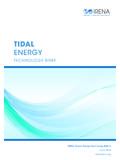Transcription of Biomass for Heat and Power Technology Brief
1 ENERGY Technology SYSTEMS ANALYSIS PROGRAMME. IRENA. International Renewable Energy Agency Biomass for Heat and Power Technology Brief IEA-ETSAP and IRENA Technology Brief E05 January 2015. This Brief is available for download from the following IEA-ETSAP and IRENA sites Copyright IEA-ETSAP and IRENA 2015. About IRENA. The International Renewable Energy Agency (IRENA) is an intergovernmental organisation that supports countries in their transition to a sustainable energy future, and serves as the principal platform for international cooperation, a centre of excellence, and a repository of policy, Technology , resource and financial knowledge on renewable energy. IRENA. promotes the widespread adoption and sustainable use of all forms of renewable energy, including bioenergy, geothermal, hydropower, ocean, solar and wind energy, in the pursuit of sustainable development, energy access, energy security and low-carbon economic growth and prosperity.
2 About IEA-ETSAP. The Energy Technology Systems Analysis Programme (ETSAP) is an Implementing Agreement of the International Energy Agency (IEA), first established in 1976. It functions as a consortium of member country teams and invited teams that actively cooperate to establish, maintain, and expand a consistent multi-country energy/economy/environment/. engineering (4E) analytical capability. Its backbone consists of individual national teams in nearly 70 countries, and a common, comparable and combinable methodology, mainly based on the MARKAL / TIMES family of models, permitting the compilation of long term energy scenarios and in-depth national, multi-country, and global energy and environmental analyses. ETSAP promotes and supports the application of technical economic tools at the global, regional, national and local levels.
3 It aims at preparing sustainable strategies for economic development, energy security, climate change mitigation and environment. ETSAP holds open workshops twice a year, to discuss methodologies, disseminate results, and provide opportunities for new users to get acquainted with advanced energy-technologies, systems and modeling developments. Insights for Policy Makers Biomass defined as organic matter derived from plants or animals available on renewable basis is used for energy applications covering a variety of practices and technologies, ranging from traditional heat production for cooking and/. or space heating to modern combined heat and Power generation or biofuels production. In 2012 bioenergy accounted for about 10% or 51 EJ of global energy demand notably larger than any other single renewable energy option.
4 Of these 51 EJ, the vast majority (27 EJ) came from the use of Biomass in traditional wood- stoves in developing countries. This figure has remained rather constant over the years. In terms of high-efficiency Biomass use and the carbon-neutral nature of Biomass combustion, growth in bioenergy utilisation is currently observed in Biomass -based electricity generation systems, accounting for approximately 6 EJ. Fluidised bed combustion, Biomass co-firing in large-scale coal Power plants and Biomass -based medium-to-small combined heat and Power (CHP) plants comprise widely-applied Technology options for Power generation. Especially Biomass co-firing reduces greenhouse gas emissions from coal-fired Power and enables efficiencies higher than those for 100% Biomass Power plants.
5 As Biomass is distributed worldwide, one of the advantages of Biomass utilisation for energy is that almost every countries can utilise their own Biomass resources. On the other hand, the energy density of Biomass is lower than that of fossil fuels. Although the Biomass pre-treatment process has been developed technically, proper collection and transportation is still required for its efficient utilisation. Seasonal/annual fluctuation in Biomass supply, due to its biological nature and environmental diversity, is another important characteristic. Taken together, these indicate that securing good quality feedstock at affordable prices over a plant's lifetime is crucial for Biomass Power projects. The multi-dimensional role that Biomass plays is one of its unique characteristics.
6 It is currently utilised for food, feed, fibre and energy supply, all using the same land for its production. It also supports different types of ecological aims, including biodiversity, greenhouse gas (GHG) emission reductions and landscape development. Bioenergy utilisation can dynamically change those relationships and produce either positive or negative impacts, both locally and globally. To enhance the multi-dimensional role of Biomass ' while mitigating the possible trade-offs associated with bio-energy deployment, an effective policy mix is needed rather than a single stand-alone policy or individual policy measures. National targets are a common measure introduced in order to ensure bioenergy markets over the medium term. A number of countries ( , Brazil, Germany, the UK) have introduced Biomass Power generation targets.
7 However, the relatively Biomass for Heat and Power | Technology Brief 1. higher cost of bioenergy can be a barrier to achieving this target. Under such circumstances, economic incentives, such as Feed-in-Tariffs (FITs) or tax credits, are required, at least at the initial stage of development. The important issue to be acknowledged when these economic incentives are introduced is that they may entail financial burdens and hinder the Technology 's development over time if incentives are set too high. A careful examination of Technology costs and trends is important so that economic measures are applied efficiently and effectively. Tariff degression introducing progressive tariff reductions is an approach to support Technology cost reductions while providing economic incentives to bioenergy developers.
8 It is crucial for investors and project developers alike that a viable bioenergy market is assured over the project's lifetime. Currently, most of the market for bioenergy has been opened and expanded in association with government policy. Thus, policy stability is the first criterion for investors and project developers to evaluate the bioenergy market during the project's lifecycle. One of the main challenges related to bioenergy is the management and optimisation of potential benefits and trade-offs, such as GHG savings, biodiversity, employment opportunities and energy/food security. A comprehensive approach which covers all the sustainability issues from their economic, environmental and social perspectives is needed. There are many ongoing initiatives, such as the Global Bioenergy Partnership (GBEP) sustainability indicators and various certification systems for sustainable forest management.
9 Discussions on sustainability criteria for solid biofuel are ongoing in EU Member Countries. More efforts are required to establish a common approach through collaboration among governments, the research and private sectors and civil society. 2 Biomass for Heat and Power | Technology Brief Technical Highlights Process and Technology Status In 2012, the total bioenergy supply was over 51 EJ, comprising some 10% of the total world's energy supply. An estimated 50% of this Biomass energy is consumed in developing countries for traditional uses ( , heating and cooking) with a very low efficiency (IRENA, 2014), while modern Biomass use for electricity production currently supplies of the electricity demand on a global scale, corresponding to about 280 TWh of electricity (IEA, 2012).
10 High-efficiency Biomass uses, such as fluidised bed combustion, co-firing with fossil fuels, CHP co-generation and gasification are rapidly increasing worldwide. The overall efficiency of Biomass -based CHP plants for industry or district heating ranges from 70%-90% (IEA, 2012). A range of Biomass pre-treatment and upgrading technologies, such as pelletisation, torrefaction and pyrolysis, have been developed in order to improve Biomass characteristics and to make handling, transportation and conversion processes more efficient and cost-effective. Biomass -fired Power and CHP plants can be characterised by their burner and boiler Technology . Water-cooled, vibrating grate (VG) boilers are an established Technology for Power generation from wood residues. Based on natural circulation, these boilers are designed to burn low-heating-value ( , LHV of about MJ/ kg) wood residues with 30% humidity.












